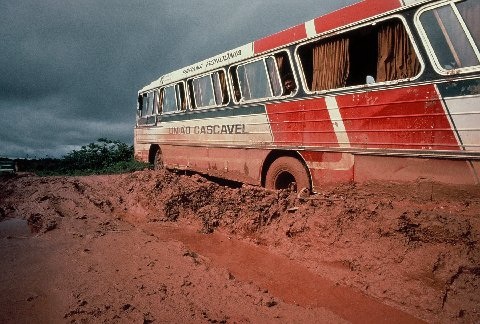 |
At 5,000 feet, the forest below looks as if moths had feasted on a dark green carpet. Great chunks have been chewed, leaving splotches of brown and black. The land is scarred this way for a hundred miles. Occasionally a road appears. If it is new, it is rusty red, a long straight tear in the green. Old roads are gray-white, and along them at intervals on either side are notches of the same color, making the old roads look like cleaned fish spines.
At 500 feet the torn patches become three-dimensional. They are strewn with thin tree trunks, charred and lying about as if blown down by a fierce hot wind.
Viewed on the ground, these abstracts become real. The carpet is the tree canopy of the largest forest on earth. The white notches are the abandoned farms where dreams of dominating this land have died. The black patches are recently burned clearings where other dreams are just beginning.
This is the Amazon jungle. If anything can reduce the sprawling, baffling region to a simple description, it is this scene. The jungle looks this way in many places, the result of an immense struggle for control between man and nature. It is that struggle that we went to the jungle to try to understand.

By the time we set out from Brasilia the vision of the Amazon as a lazy tropical paradise had left our minds. London's first impressions of poisonous snakes and Indians with blowguns hunting monkeys now seemed imagined; the Amazon even had fire hydrants, an executive of the national utilities company had told us.
We chose to begin in Cuiaba, the capital of the State of Mato Grosso. Known as the gateway city to the Amazon, Cuiaba has served as the link between the settled south and the unexplored north for almost a century. Brazil's horizon once ended here. Only recently has the government and the rest of the country stopped believing that beyond the horizon is an untamable forest which swallows up all who enter. News has begun to flow back through Cuiaba to the displaced tenant farmers in the south, the urban slum dwellers around Sao Paulo and the drought-stricken peons to the northeast that this land can sustain life. They flock through here in droves now, funneling thickly into the bus station, waiting to trail out again along the roads to the jungle.
We went to the cavernous precast-concrete bus station in Cuiaba to capture sights and sounds of lives in transition. It was our first visit into the field. Still shy and tentative, we didn't talk to anyone, just walked around and eavesdropped. The station was in a frenzy. It looked as if many of the people had been there for days, sleeping contorted among an array of fraying suitcases, cardboard boxes and plastic-wrapped parcels-the baggage of a people in flight. Many of the women were pregnant, and many more were burdened with wailing infants. Men congregated in bunches and we heard them mention towns like Ouro Preto and Ariquemes, which are being settled according to INCRA's plan. We heard them talk of indios with the same curious tone we had-- what were Indians like, what did they want? We heard talk of violencia but not of what caused it.
Our impressions were inexact, of course. We were as nervous as these travelers, for Cuiaba was our watershed, too. Yet we knew we were going on, and so did they. Most of the men wore new straw cowboy hats. The talk of fears, problems, and danger seemed just talk: they would not be stopped. All the men had to do was look over their shoulders to see their families and belongings, all on the floor of the Cuiaba bus station. Their decisions had been made. They were living a great dream. No doubt, there had corne a time when they, like Huck Finn, had said to themselves, "I reckon I got to light out for the territory ahead of the rest." |
 |
| |
Amazon
an unforgettable account of an extraordinary adventure through the last great wilderness on earth
By Brian Kelly and
Mark London
Henry Holt and Co. (1985)
Buy the Book
|
|
| |

|
 |
|
 |

